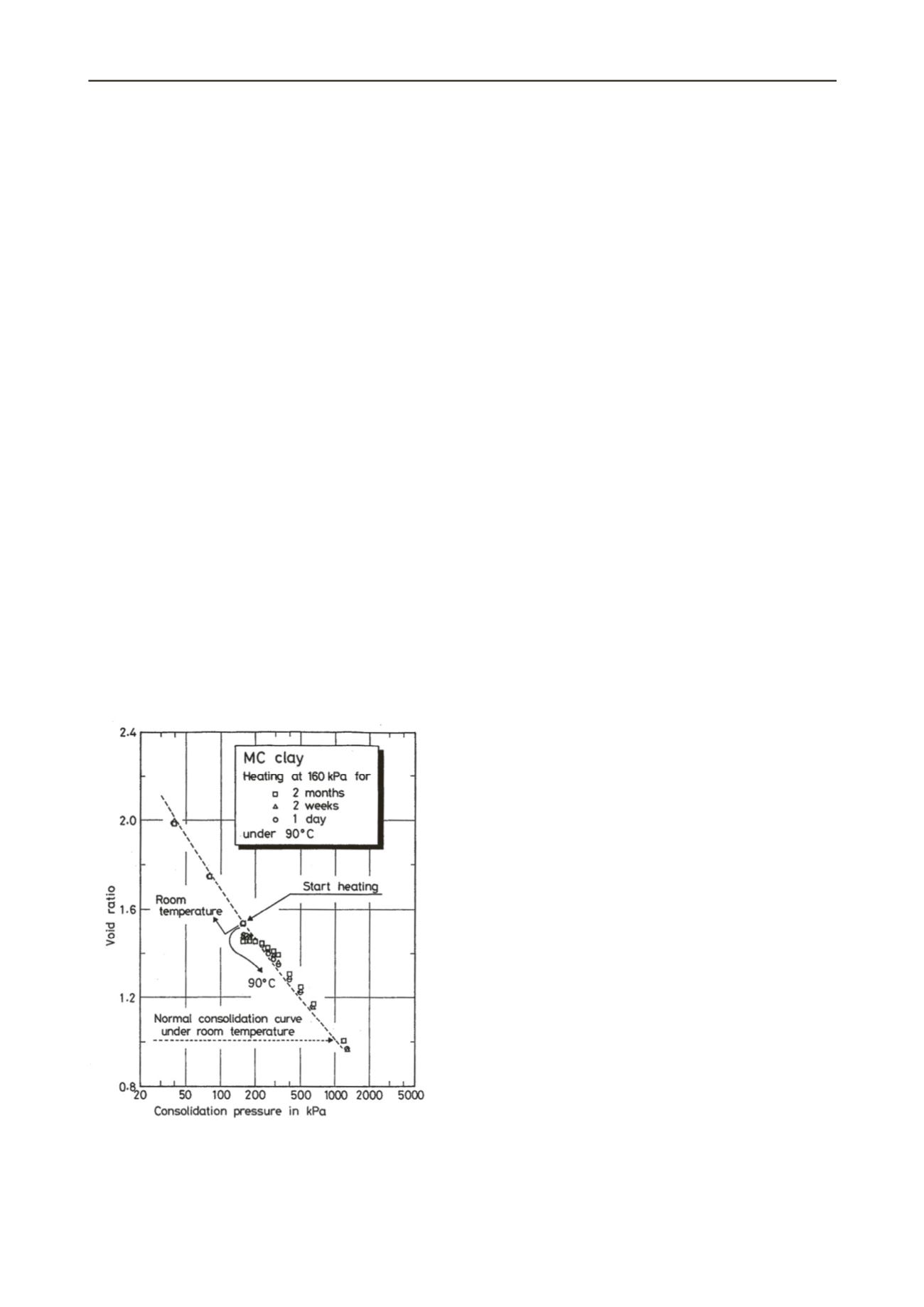
3414
Proceedings of the 18
th
International Conference on Soil Mechanics and Geotechnical Engineering, Paris 2013
3.3
Discussions
4 CONCLUSIONS
Two important effects on compressibility caused by the
changing temperature were identified in this study. One is the
so-called viscous behaviour due to high temperature conditions
observed in the phase of “a-b” in Fig. 3: that is,
p’
c
decreases
with an increase in
T
. Another effect is the gaining of the ability
to resist deformation, i.e., decreasing
C
c
with an increase in
T
.
This effect becomes much more prominent when the strain rate
is smaller, as observed in the phase of “c-d” under
vp
0
/100 in
Fig. 5; normalized
p’
at given
vp
is larger for higher
T
. As a
result, in the phase of “d-e-f” in Fig. 5, the
vp
-log (
p’
/
p’
1
)
curve at 50
℃
considerably overshoots the corresponding
ESRL
0
vp
, as if the clay specimen experienced ageing in the
previous phase of “c-d”. However, this overshoot is destructed
by the faster loading under
vp
0
and the
vp
-log (
p’
/
p’
1
) curves
return to their original trend.
To examine the combined effects of temperature and strain rates
on the consolidation properties of clay, a series of CRS tests, in
which the strain rate was not constant but changed during the
test, was carried out at temperatures of 10
℃
and 50
℃
for
reconstitutedLouisevilleclay
samples.
The
following
conclusions were drawn:
1) The hydraulic conductivitywas strongly dependent on
temperature. The reason for this is that the water viscosity
increases with a decrease in temperature. As a result, the
excess pore water pressure generated in the specimen at 10
℃
was much higher than that at 50
℃
.
According to Tsuchida et al. (1991), an increase in
temperature provides the same effect as ageing on clay samples.
They mentioned that this ageing is caused by cementation and
this cementation is accelerated by an increase in temperature. A
similar ageing effect was also reported byTowhata et al. (1993).
In Fig. 7, cited from Towhata et al. (1993), clay samples were
subjected by incremental step loadings after applying a load of
160kPa at 90
℃
for various durations of time. The
e
-log
p’
relationship for heated samples shifts to higher
p’
in comparison
to the reference relationship obtained by the end of primary
consolidation indicated by the dotted line. They considered that
such an ageing effect was caused by the acceleration of
secondary consolidation: i.e., clay particles are closely
rearranged because an increase in temperature reduces the
viscosity of the adsorbed water layer on the surface of soil
particles. As a result, the specimen develops a new structure,
exhibiting higher stiffness against subsequent loading. It may be
also considered that some types of structure are created during
the loading process in the CRS test and its creation is
considerably accelerated under high temperature conditions.
2) The yield effective stress decreased with increasing
temperature, indicating that the clay specimens exhibited
viscous behaviour by heating. However, such a viscous effect
disappeared with a decrease in the void ratio (
e
) during a
subsequent loading: under the higher level of the effective
stress (
p’
). That is, the slope of the
e
-log
p’
curve at 50
℃
at
the normally consolidated state (
C
c
) was smaller than that at
10
℃
.
3) The tendency of a decrease in
C
c
, i.e., lowering
compressibility, was more prominent under the loading
condition of small strain rate.The reason for a decrease in
C
c
under high temperature at small strain rate may be attributed
to the structure created.This explanation may be applied to
the observed phenomenon of overshooting the
e
-log
p’
, when
the strain rate was increased.
5 REFERENCES
Eriksson L.G. 1989.Temperature effects on consolidation properties of
sulphide clays.
Proc.the 12th Int. Conf. on Soil Mechanics and
Foundation Engineering
3,2087-2090.
Japanese Standards Association 2009. Test methods for permeability of
saturated soils,
JIS A 1218: 2009
, 1-12 (in Japanese).
Japanese Standards Association 2009. Test method for one-dimensional
consolidation properties of soils using constant rate of strain
loading,
JIS A 1227: 2009
, 1-14 (in Japanese).
Leroueil S., Kabbaj M., Tavenas F. and Bouchard R. 1985.Stress-strain-
strain rate relation for the compressibility of sensitive natural
clays.
Geotechnique
35(2), 159-180.
National Institutes of Natural Sciences, National Astronomical
Observatory of Japan 2004.Chronological Scientific Tables (in
Japanese).
Šuklje L. 1957.The analysis of the consolidation process by the isotache
method.
Proc. 4th Int. Conf. on Soil Mech. Found. Engng.
1, 200-
206.
Tanaka H., Shiwakoti D.R., Mishima O., Watabe Y. and Tanaka M.
2001. Comparison of mechanical behavior of two overconsolidated
clays: Yamashita and Louiseville clays.
Soils and Foundations
41(4),
73-87.
Tanaka H. 2005.Consolidation behavior of natural soils around
p
c
value
–Inter-connected oedometer test–.
Soils and Foundations
45(3), 97-
105.
Towhata I., Kuntiwattanaku P. Seko I. and Ohishi K. 1993. Volume
change of clays induced by heating as observed in consolidation
tests.
Soils and Foundations
33(4), 170-183.
Tsuchida T., Kobayashi M. and Mizukami J. 1991.Effect of ageing of
marine clay and its duplication by high temperature
consolidation.
Soils and Foundations
31(4), 133-147.
Tsutsumi A. and Tanaka H. 2011.Compressive behavior during the
transition of strain rate.
Soils and Foundations
51(5), 813-822.
Figure 7. Thermal aging behaviour obtained from incremental loading
consolidation test after Towhata et al. (1993).


